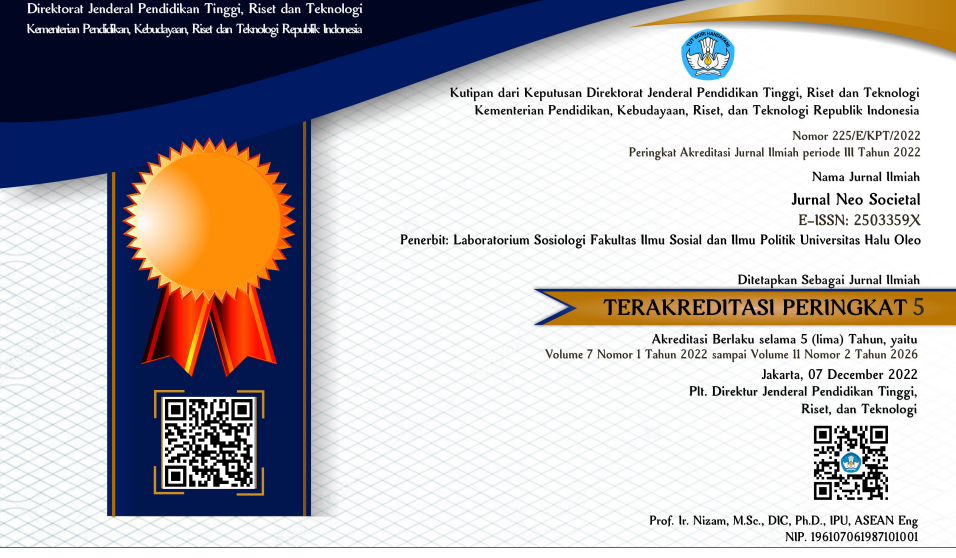Wanita Dalam Falsafah Jawa
(Analisis Kekerasan Simbolik Terhadap Wanita)
Keywords:
Javanese women, symbolic violence, BourdieuAbstract
This article analyzes injustice against women in Javanese philosophy with the theory of symbolic violence used as a point of view to reveal how gender inequality occurs in the form of violence against women who are required to submit and obey their husbands and parents. Using qualitative methods with an ethnographic approach, the researcher wants to present how Javanese women's views on life have been passed down from generation to generation regarding the position of women as a result of Javanese philosophy. The results of the research show that Javanese women should not dispute orders from their parents or husband. This research concludes that the gender inequality that occurs between men and women in Javanese philosophy limits women in expressing their opinions, especially in public spaces where the gender domination experienced by women is one of the underlying causes of symbolic violence.
References
Haryatmoko. Etika Komunikasi: Manipulasi Media, Kekerasan Dan Pornografi. Yogyakarta: Kanisius, 2007.
Kawan, Sri. “Pakeliran Wayang Kulit Purwa Lakon Sinta Obong.” ISI Yogyakarta, 2017.
Krisnalita, Louisa Yesami. “Perempuan, HAM Dan Permasalahannya Di Indonesia.” Binamulia Hukum 7, no. 1 (2018): 71–81. https://doi.org/10.37893/jbh.v7i1.15.
Kurniasari, Netty Dyah. “Bias Gender Dalam Bahasa (Analisis Tekstual Terhadap Falsafah Dan Ajaran Jawa).” Seminar Nasional Gender& Budaya Madura III Madura: Perempuan, Budaya & Perubahan, 2016. https://lppm.trunojoyo.ac.id/budayamadura/wp-content/uploads/2016/10/2-7.-ARTIKEL.pdf.
Megawangi, Ratna. Membiarkan Berbeda. Bandung: Mizan Pustaka, 2001.
Musdawati. “Kekerasan Simbolik Dan Pengalaman Perempuan Berpolitik Di Aceh.” Jurnal Justisia 2, no. 2 (2017).
Mutmainah, Nurfitri. “Peran Perempuan Dalam Pengembangan Ekonomi Melalui Kegiatan UMKM Di Kabupaten Bantul.” WEDANA: Jurnal Kajian Pemerintahan, Politik Dan Birokrasi 6, no. 1 (2020): 1–7. https://journal.uir.ac.id/index.php/wedana/article/view/4190.
Nanang Martono. Kekerasan Simbolik Di Sekolah (Sebuah Ide Sosiologi Pendidikan Pierre Bourdieu). Jakarta: Raja Grafindo, 2012.
Pierre Bourdieu. Choses Dites: Uraian Dan Pemikiran, Terj. Ninik Rochani Sjams. Yogyakarta: Kreasi Wacana, 2011.
———. “Language and Symbolic Power.” Cambridge: Polity Press, 1991.
Sendratari, Luh Putu, and Tuty Maryati. Sejarah Wanita: Perspektif Androgynous. Yogyakarta: Graha Ilmu, 2014.
Sulastri. “Falsafah Hidup Perempuan Jawa.” Jurnal Sanjiwani 10, no. No. 1 (2019).
Tim Penyusun Kamus Pusat Bahasa. Kamus Besar Bahasa Indonesia. Jakarta: Balai Pustaka, 2005.
Wahyudi, Very. “Peran Politik Dalam Perspektif Gender.” Politea: Jurnal Politik Islam 1, no. 1 (2018): 63–83.
Yusanto, Yoki. “Ragam Pendekatan Penelitian Kualitatif.” Journal of Scientific Communication (Jsc) 1, no. 1 (2020): 1–13. https://doi.org/10.31506/jsc.v1i1.7764.
Downloads
Published
How to Cite
Issue
Section
License
Copyright (c) 2024 Arum Kholifatul Alyyah -, Kiki Luluk Khondziroh

This work is licensed under a Creative Commons Attribution 4.0 International License.













